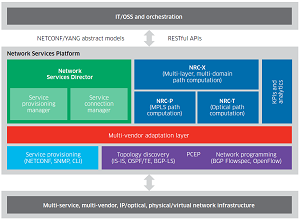News
Alcatel-Lucent Claims First Carrier SDN Platform
Global communications company Alcatel-Lucent today unveiled what it claims to be the first unified software-defined networking (SDN) platform for the service provider industry.
The French company said its new SDN-based Network Services Platform (NSP) is the first product to enable telecommunications carrier SDN through the unification of service automation with network optimization of both IP-based and optical networks.
The product bridges the worlds of IT and operational support systems (OSS), the company said, providing a customizable, on-demand network that helps carriers provision resources in seconds across multiple components such as layers, domains and vendor platforms, similar to the way cloud services providers handle enterprise customer computing demands.
"The Network Services Platform bridges the gap between service design, provisioning and network engineering for the first time, to allow operators to cost-efficiently define new services and activate them in real-time," the company said in a statement. "Using purpose-built SDN-based software that blends Alcatel-Lucent's expertise in service management as well as in the creation and management of large-scale IP/MPLS routing and optical networks, it offers a unified approach to the automation and control of a broad range of services in carriers' IP/optical infrastructures.
 [Click on image for larger view.]Network Services Platform Architecture (source: Alcatel-Lucent).
[Click on image for larger view.]Network Services Platform Architecture (source: Alcatel-Lucent).
"It also gives full visibility of the state of the network across all layers at all times, allowing automatic multi-layer service provisioning, to use the best available network resources as well as real-time network optimization."
Alcatel-Lucent referred to testing conducted by research firm ACG that indicate network operation performance boosts in multiple areas with its NSP. Defining services can be done 58 percent faster than with other solutions, it said, at a 56 percent lower cost. Once defined, the services can be provisioned instantly across the multiple-component systems.
"In addition, Bell Labs research shows that operators are also able to support 24 percent more revenue-generating traffic by using sophisticated algorithms to intelligently distribute new connections across their network," the company said. Alcatel-Lucent noted that the 24 percent boost is made possible through technology provided by Bell Labs and its consulting group.
The self-tuning, adaptable algorithms establish the most efficient paths through a network based on information such as the state of a network's topology, link traffic and use. "For example, service providers can move paths to avoid network congestion or dynamically release locked bandwidth to allow additional customer services to be added," Alcatel-Lucent said.
A network architect at British telecommunications giant BT Group also lauded the new product.
"In order for SDN to mean we can really improve our customer experience and impact our network economics, we need approaches that consider the real-time state of the network and relate it to the requirements of the service we provide," BT's Rob Shakir was quoted as saying in a statement. "Doing so allows us to assure performance, and optimize resource usage across all our network layers. Tightly coupling service requirements and performance with network control ... promises to deliver real-world benefits of centralized optimization whilst exploiting the strength of our existing distributed network."
Alcatel-Lucent said the new NSP is an extension of what the company's Nuage Networks venture has done in the datacenter. Nuage recently announced it has addressed the overlay/underlay visibility problem in SDN and has formed multiple partnerships and expanded its SDN ecosystem.
In a video interview, Alcatel-Lucent's Steve Vogelsang said NSP extends what the company learned in helping enterprises automate their networks to respond to the demands of cloud applications. Although there are some commonalities between the two approaches, there were also some new problems to solve. "What we discovered, then, as we extend that into the WAN, we need to actually control the underlying network infrastructure and make sure the capacity is there. We really need to tie together the network itself, as well as the applications that run on top of the services."
The new NSP will be commercially available next month.
About the Author
David Ramel is an editor and writer for Converge360.